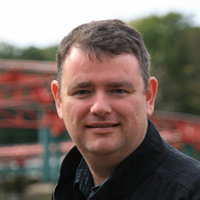To
me there is something very special about the dark
ride. Sitting at the far corner of the amusement
park, the fascination is that you just don’t know
what lurks inside the dark and dingy building that
lies behind the peeling paint of the plywood façade.
In some ways, the older and shabbier the better, as
it all adds to the experience.
Dark rides are all about immersing yourself in
another world, whether that world is a haunted
castle surrounded by a fog-covered graveyard or a
colourful toy workshop. The little car (or boat)
guides you through this perfectly timed show,
pushing you into the clutches of some giant, hairy
spider. You have absolutely no control. And that is
the key to the long-lasting appeal of the dark ride.
I remember watching a Channel 4 documentary about
trains (of the steam – not the ghost – variety) a
few years ago, narrated by John Peel. The reason I
watched it was solely because I knew it was briefly
going behind the scenes of the Ghost Train at Rhyl’s
Ocean Beach Amusement Park. The cameras took the
viewer behind the faded façade into seemingly miles
of twisting, turning track. Inside were the usual
assortment of crumbling papier mache monsters and
illuminated skeletons dangling from ceilings behind
chicken wire. John Peel noted that the entire
twisting, turning track was inside a building no
bigger than the typical suburban bungalow. And he is
right; most dark rides at British amusement parks
(with a few notable exceptions) would fit into your
typical 3-bedroom bungalow. In fact, many travelling
ghost trains in this country do literally fit inside
the back of a lorry, despite the fact that they have
facades that suggest that you are entering a
building the size of a typical Tesco supermarket.
Many dark rides at Britain’s amusement parks also
fall firmly in the category of being ‘vintage’
rides. And most were self-built by the park in
question, meaning that there is no ‘typical’ dark
ride. Overlooked they may be, but they are certainly
worth a closer look. Here, then, is my potted
history of the dark ride. So take our seat, keep
your hands in the car at all times and – remember –
you might just be scared out of your wits!
The dark ride has been a mainstay of amusement parks
and travelling fairs for over 100 years. The history
of ghost trains in the UK can be traced back to the
travelling fairground shows of the 1800s. In the
days before thrilling rides, travelling fairs were
primarily about shows - freak shows, waxworks and
theatrical booths - and the ghost train takes its
roots from this tradition. By the mid-1800s, Ghost
Shows (theatrical productions, which often took
place in booths on the fairground) were a major part
of the travelling fairground scene.
The development of the ghost train in the last
century can be linked to these 19th Century shows.
Ghost trains are merely an extension of the
fairground ghost show concept to allow the new-found
technologies of the last hundred years to turn the
show into a ride and add a whole new dimension of
movement to the experience. In more recent years,
however, the ghost show has expanded to include
themed fantasy rides and rides which take passengers
on journeys around the globe.
The earliest dark rides were pioneered
simultaneously in the UK and the US. The ‘tunnels of
love’ or ‘river caves’ were the earliest form of
dark ride. These slow-moving boats took riders on a
romantic tour of far-flung places around the world.
In the UK, the modern amusement park dark ride can
be traced back to Blackpool Pleasure Beach, which
itself had borrowed ideas from the huge exhibitions
that were once held in the UK. The Pleasure Beach
had installed the River Caves in 1910 and this was a
rebuild of the river caves ride at London’s Earl’s
Court Exhibition of 1909. This must have been a
particularly awe-inspiring ride in the days when
even Blackpool itself was considered to be an exotic
destination by most people in Britain. Even to this
day, this ride impresses.
In the late 1920s, always looking to install the
latest thrill from the USA, the Pleasure Beach
decided to borrow one of the big hits from across
the pond. The early part of the last century saw a
boom in dark ride construction in the USA. These
‘pretzel rides’, as they were called, were named
after the Pretzel Company that made many of these
dark rides. The Pleasure Beach decided to build
their own pretzel ride. As the name Pretzel was
little known in the country and didn’t give much of
a clue as to the ride itself, the park adopted the
name ‘Ghost Train’, which was taken from a popular
stage show of the time. The name stuck, and has been
adopted as the generic name for this type of dark
ride in amusement parks and travelling fairs across
the United Kingdom, and still continues to be used
to the present day.
Following the opening of Blackpool Pleasure Beach’s
huge Ghost Train ride (opening year 1930), other
major amusement parks installed similar rides:
Dreamland (Margate), Pleasure Beach (Great Yarmouth)
and Pleasureland (Southport) all had their own dark
rides. Even holiday camp king Billy Butlin installed
ghost trains in each of his chain of seaside
amusement parks.
In 1936, Blackpool Pleasure Beach decided to install
a larger ghost train and commissioned architect
Joseph Emberton (the man behind the Casino building,
Grand National station and Fun House, amongst other
iconic Pleasure Beach structures) to design it. It
had a hugely impressive frontage, opening up into
what could only be described as a giant stage set,
complete with roller coaster-style drop in the
centre. The main ‘stage’ was flanked on either side
by balconies, which served to add an extra moment of
excitement for the riders and show park visitors
that this ride was not only on one level, but two.
The roller coaster-style drop has since been
employed on many other ghost trains, including rides
at Bridlington, Walton Pier, Dymchurch, Brean
Leisure Park and, until recently, Morecambe and
Brighton. (Morecambe’s ghost train closed at the end
of the 1999 season, but part of the ride system was
resurrected at Brean Leisure Park. Brighton Pier’s
ghost train was destroyed by fire in early 2003).
The first floor balconies are also much copied.
Ghost trains also became hugely popular in the
travelling fairs in the 1940s and 1950s. These rides
were basically buildings that were built up from
scratch, and required a large team of people to
construct them. By the 1960s and 1970s, showmen were
looking for rides that could be built up more
quickly, and that really marked the end of the great
travelling ghost train. More recent years have seen
a revival in the travelling ghost train. But the
quest to make rides easier to build up and pull down
has meant that most are now lorry or trailer mounted
(i.e. the entire ride sits in the “back of a
lorry”), so they are limited by space. The lack of a
large amount of interior space has been offset
somewhat by the huge foldout flash sported by many
rides, which are often on several levels. A typical
early British travelling ghost train can be found at
Folly Farm (Begelly, South Wales).
On the continent, things are very different. Large
ghost trains and other dark rides, many comparable
to British amusement park ghost trains, are
travelled, and require a small army of men to build
up and pull down.
Dark rides have continued to develop over the past
few decades. The 1990s saw a mini-boom in
water-based dark rides. This was started by
Professor Burp’s Bubbleworks at Chessington World of
Adventures, which has spawned many a copy. The turn
of the Century saw the construction in the UK of
what many consider to be the most spectacular dark
ride of them all – Valhalla at Blackpool Pleasure
Beach. And it is fitting that this ride should be
built at what is undoubtedly the home of the dark
ride. This new ride flips the idea of the river
caves on its head. The boat is no longer merely a
means of transportation – it is part of the thrill
of the ride, with fast drops (one taken in reverse),
and spectacular special effects, involving wind,
fire, ice and lightning. The ride really does take
the breath away.
But the new millennium has seen a worrying trend.
The current fad for TV interior design and garden
makeover shows has spilt over into the dark ride
world and now we have – yes - dark ride makeovers.
Perfectly good dark rides are being ripped apart,
the trains equipped with ‘laser guns’ for
interactive shoot-out rides. Maybe I am getting old,
but this concept really goes against the whole point
of the dark ride. As I said above, the dark ride is
all about immersing yourself in another world; the
car is in control – you are a helpless passenger.
With shootouts, the rider is now in control, and the
ghost train simply becomes a large arcade game. How
can you be frightened of ghosts if you are armed
with a gun? Excellent dark rides at Chessington
World of Adventures and Alton Towers have already
been lost to these makeovers.
There are many interesting dark rides in this
country that are well worth checking out. I can
recommend the following: Haunted Mine (Barry Island
Pleasure Park, Barry Island); Ghost Train (Bayside
Fun Park, Bridlington); Ghost Train, River Caves,
Gold Mine, Alice’s Wonderland, Magic Mountain,
Valhalla (Blackpool Pleasure Beach); Ghost Train (Botton’s
Pleasure Beach, Skegness); Terror Castle (Brean
Leisure Park, Brean Sands); Professor Burp’s
Bubbleworks (Chessington World of Adventures); Ghost
Train (Coney Beach Amusement Park, Porthcawl);
Terror Train (Coral Island, Blackpool); Pirate
Adventure (Drayton Manor, Tamworth); Ghost Train (Funland,
Pwllheli); Haunted Hotel (Pleasure Beach, Great
Yarmouth); Ghost Train (MW’s Amusement Park,
Dymchurch); Voodoo Mansion (Oakwood, Narberth);
Ghost Train, Haunted Silver Mine (Ocean Beach Fun
Fair, Rhyl); Ghost Train and River Caves
(Pleasureland, Southport).
The above list only scratches the surface of dark
rides in the UK. Be warned: you will find a dark
ride lurking in the corner of just about every
amusement park in the country and most are worth a
ride. But please contact me if you see Carol Smillie
and her makeover team anywhere near one!
|
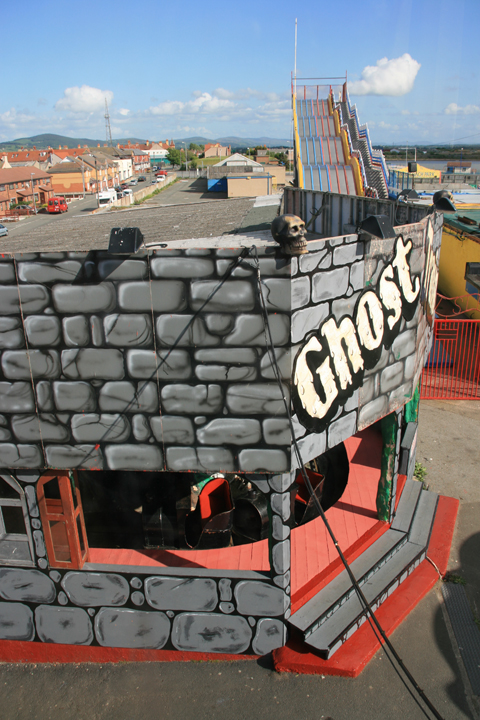
Ghost
Train at Ocean Beach Amusement Park, Rhyl (May
2007): "No bigger than a typical suburban bungalow".
Photograph: Nick Laister
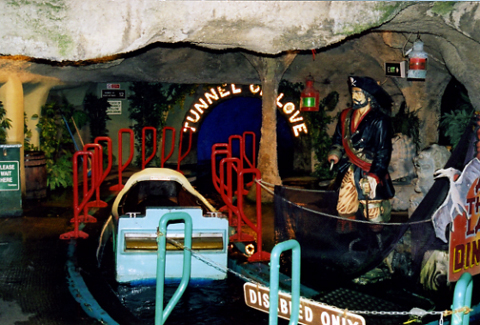
The
River Caves at Pleasure Beach, Blackpool (2002).
Photograph: Nick Laister
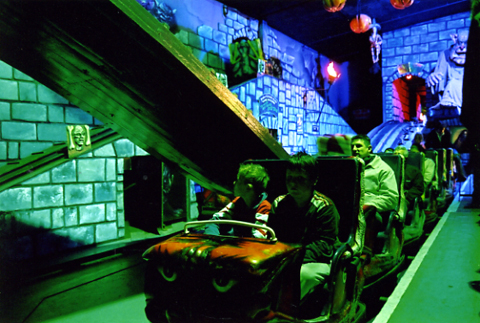
The
Ghost Train at Pleasure Beach, Blackpool (2003),
with the "roller coaster-style drop" behind the line
of cars. Photograph: Nick Laister
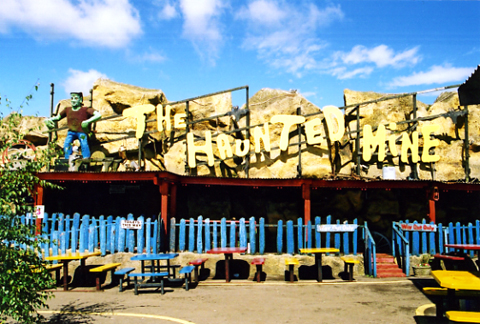
The
Haunted Mine at Barry Island Pleasure Park (2001).
Photograph: Nick Laister
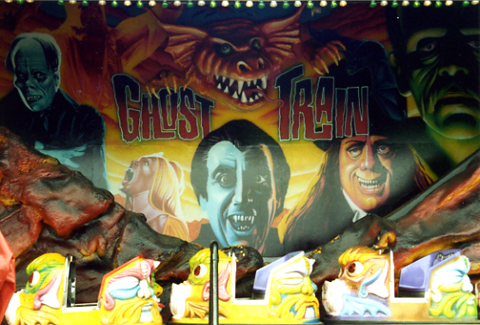
The
Ghost Train at Bayside Fun Park, Bridlington (2001),
built into the Floral Pavilion which had been
incorporated into the amusement park in the 1990s.
The ride was removed shortly after this photograph
was taken. Photograph: Nick Laister
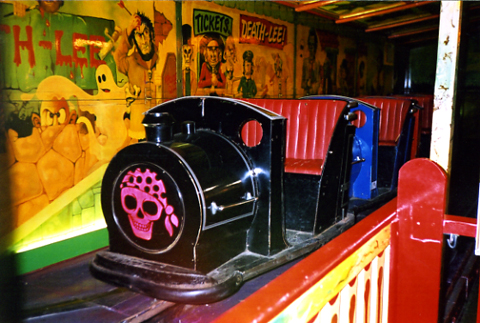
An
early travelling ghost train at Folly Farm near
Begelly, South Wales (2001). Photograph: Nick
Laister |







